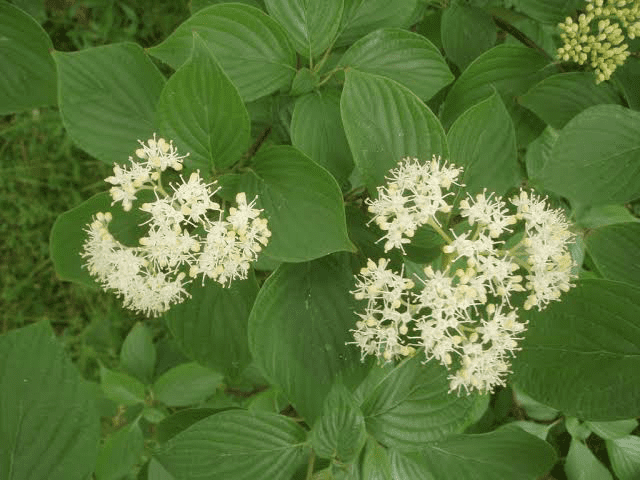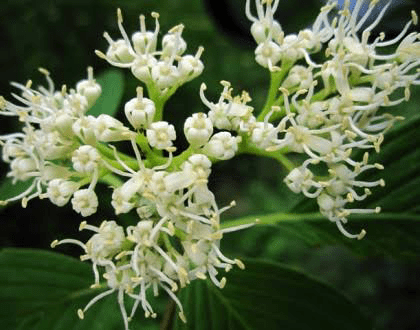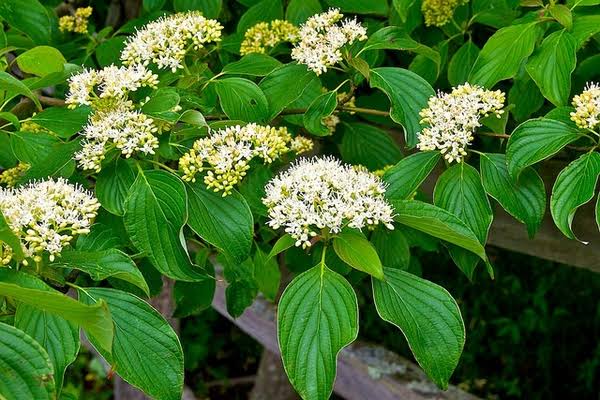Cornus alternifolia, commonly known as Pagoda Dogwood, is a fascinating plant with a rich history of medicinal use. This article explores the various health benefits associated with this unique botanical specimen and delves into its botanical description.
For centuries, indigenous cultures in North America have recognized the healing properties of Cornus alternifolia. The bark, leaves, and roots of this plant have been employed for a wide range of medicinal purposes. Let’s delve into its historical significance in traditional medicine and discover how it has played a crucial role in promoting human well-being.
The Botanical Description of Cornus alternifolia
Cornus alternifolia is a deciduous shrub or small tree that belongs to the Cornaceae family. Its botanical description is both intriguing and important for understanding its medicinal potential. Here are six key aspects of the botanical description of Cornus alternifolia:
1. Growth Habit: Cornus alternifolia exhibits a distinctive growth habit. It typically grows as a multi-stemmed shrub or a small tree, reaching heights of up to 15 feet. Its branching pattern resembles the layers of a pagoda, hence the common name “Pagoda Dogwood.”
2. Leaves: The leaves of Cornus alternifolia are arranged alternately along its stems, which is a characteristic feature of this species. They are ovate to elliptic in shape and possess a glossy, dark green color. In the fall, these leaves turn various shades of red and purple, adding ornamental value to gardens.
3. Flowers: During the spring, Cornus alternifolia produces clusters of small, creamy-white flowers. These flowers have a pleasant fragrance and attract pollinators, making the plant an excellent addition to pollinator-friendly gardens.
4. Fruits: Following the flowering stage, Pagoda Dogwood develops distinctive bluish-black berries. These berries are a crucial component of the plant’s medicinal use and provide essential nutrients for wildlife.
5. Bark: The bark of Cornus alternifolia is known for its unique appearance. It has a distinctive mottled or “checkerboard” pattern, with colors ranging from gray to brown. Native Americans used the bark for various medicinal purposes, contributing to the plant’s historical significance.
6. Habitat and Range: Cornus alternifolia is native to eastern North America and can be found in a variety of habitats, including woodlands, streambanks, and forested slopes. Its adaptability to different environments has made it a versatile and valued plant in traditional medicine.
The Geographic Distribution of Cornus alternifolia
The geographic distribution of Cornus alternifolia, also known as Pagoda Dogwood, is a crucial aspect to consider when exploring its medicinal potential. Here are six key points regarding the geographic distribution of this remarkable plant:
1. Native Range: Cornus alternifolia is primarily native to eastern North America, including regions of the United States and Canada. Its natural habitat spans from Newfoundland and Labrador in the north to Georgia and Alabama in the south.
2. Preferred Habitats: This species thrives in various habitats, including deciduous woodlands, riparian areas, and the understory of mixed forests. It shows a preference for moist, well-drained soils.
3. Range Extension: In recent years, efforts have been made to extend the range of Cornus alternifolia through horticultural cultivation. This has allowed it to adapt to more diverse environmental conditions beyond its natural range.
4. Landscape Use: Due to its attractive appearance, Pagoda Dogwood is often cultivated as an ornamental shrub in gardens and landscapes, further expanding its geographical presence.
5. Hardy Zones: Cornus alternifolia is well-suited to USDA hardiness zones 3 to 7, making it adaptable to a wide range of climates, from cold northern regions to milder southern areas.
6. Conservation Status: Although not currently listed as endangered, conservation efforts are essential to protect wild populations of Cornus alternifolia and ensure its continued presence in its native range.
The Chemical Composition of Cornus alternifolia
Understanding the chemical composition of Cornus alternifolia is essential to unlock its medicinal potential. Here are five key components found in this plant:
1. Iridoids: Cornus alternifolia contains iridoids, which have been associated with anti-inflammatory and antioxidant properties. These compounds play a role in the plant’s medicinal applications.
2. Anthocyanins: The berries of Pagoda Dogwood are rich in anthocyanins, known for their potential health benefits, including antioxidant and anti-inflammatory effects.
3. Tannins: Tannins are present in the bark of Cornus alternifolia. They contribute to the plant’s historical use in traditional medicine for astringent and wound-healing purposes.
4. Organic Acids: Organic acids, such as citric and malic acid, are found in the fruits of Cornus alternifolia, contributing to their tart taste and potential health benefits.
5. Essential Oils: Some volatile compounds, like essential oils, may be present in the leaves and flowers, adding to the plant’s overall chemical diversity.
The Cultivation and Growth of Cornus alternifolia
Cultivating and growing Cornus alternifolia is of great interest for those looking to harness its medicinal properties. Here are six key aspects of its cultivation and growth:
1. Soil Requirements: Cornus alternifolia thrives in well-drained, acidic to neutral soils. It is adaptable to various soil types but prefers moist conditions.
2. Light Conditions: Partial to full shade is ideal for Pagoda Dogwood, making it suitable for understory planting in forested areas or shaded gardens.
3. Watering Needs: Regular watering is essential, especially during dry periods, to ensure the plant’s healthy growth and berry production.
4. Pruning: Pruning can help maintain a desired shape and size for ornamental purposes and promote better air circulation within the plant.
5. Propagation: Propagation methods include seeds, stem cuttings, and root cuttings. Seed germination can be slow, so patience is required.
6. Disease Resistance: Cornus alternifolia is relatively resistant to pests and diseases, making it a low-maintenance plant for cultivation.
The Harvesting and Processing of Cornus alternifolia
Efficient harvesting and processing techniques are essential to harness the medicinal potential of Cornus alternifolia. Here are nine steps involved in the harvesting and processing of this plant:
1. Timing of Harvest: The optimal time to harvest various parts of Cornus alternifolia, such as the bark, leaves, and berries, depends on the intended use. For bark, late winter or early spring is often recommended.
2. Ethical Harvesting: Ensure sustainable harvesting practices by not overharvesting from wild populations. Cultivating your own Pagoda Dogwood can provide a renewable source.
3. Bark Collection: When harvesting bark, carefully remove small strips, avoiding excessive damage to the plant. This can be done when the plant is dormant.
4. Leaf Harvest: Leaves can be harvested during the growing season, ideally in the early summer when they are at their most vibrant and healthy.
5. Berry Harvest: Berries should be collected when fully ripe, typically in late summer to early fall. Ensure they are free from disease or damage.
6. Drying: Properly dry harvested materials in a well-ventilated area away from direct sunlight to preserve their medicinal properties.
7. Storage: Store dried plant materials in airtight containers in a cool, dry place to maintain their quality.
8. Processing for Medicinal Use: Depending on the intended use, Cornus alternifolia can be further processed into tinctures, teas, or extracts.
9. Quality Control: Regularly check stored materials for signs of degradation or spoilage and discard any compromised samples.
By following these steps, you can ensure that you harvest and process Cornus alternifolia in a way that maximizes its medicinal benefits while promoting sustainability and plant health.
Read Also: 6 Medicinal Health Benefits Of Genista tinctoria (Dyer’s greenweed)
The Medicinal Health Benefits Of Cornus alternifolia (Pagoda Dogwood)

Cornus alternifolia, or Pagoda Dogwood, boasts a wide array of medicinal health benefits. Here are 18 key benefits of this remarkable plant:
1. Anti-Inflammatory Properties: The bark and leaves of Cornus alternifolia contain compounds with anti-inflammatory effects, making them useful for addressing inflammatory conditions.
2. Antioxidant Action: The high content of antioxidants in Pagoda Dogwood berries can help combat oxidative stress and support overall health.
3. Immune System Support: Consuming Pagoda Dogwood products may boost the immune system, helping the body fight off infections.
4. Pain Relief: The plant’s anti-inflammatory properties can contribute to pain relief, particularly for conditions like arthritis.
5. Digestive Aid: Cornus alternifolia may help soothe digestive issues and alleviate discomfort.
6. Heart Health: Antioxidants in the berries can contribute to heart health by reducing the risk of cardiovascular diseases.
7. Respiratory Health: Infusions or tinctures of Pagoda Dogwood may help alleviate respiratory conditions like coughs and colds.
8. Skin Health: Topical applications of Cornus alternifolia extracts may improve skin conditions, thanks to its anti-inflammatory properties.
9. Stress Reduction: Consuming Pagoda Dogwood products may have a calming effect, reducing stress and anxiety.
10. Menstrual Symptom Relief: The plant’s anti-inflammatory properties may help alleviate menstrual cramps and discomfort.
11. Antimicrobial Action: Cornus alternifolia extracts may have antimicrobial properties, aiding in the treatment of infections.
12. Vision Support: The plant’s high anthocyanin content can benefit eye health.
13. Bone Health: Pagoda Dogwood may contribute to bone health by providing essential nutrients.
14. Antiviral Properties: Research suggests that some compounds in the plant may exhibit antiviral activity.
15. Anti-Cancer Potential: While not a cure, Pagoda Dogwood’s antioxidants may play a role in cancer prevention.
16. Urinary Tract Health: Infusions made from the leaves may help with urinary tract issues.
17. Anti-Aging Effects: The antioxidants in Pagoda Dogwood can help combat signs of aging.
18. Blood Sugar Control: There is evidence to suggest that some compounds in the plant may help regulate blood sugar levels.
Methods of Usage to Achieve the Provided Health Benefits Of Cornus alternifolia (Pagoda Dogwood)
To harness the health benefits of Cornus alternifolia, here are seven methods of usage:
1. Infusions: Prepare herbal teas by steeping dried leaves or berries in hot water to enjoy the plant’s healing properties.
2. Tinctures: Create alcohol-based extracts using the bark, leaves, or berries for convenient and potent dosing.
3. Topical Applications: Apply creams or ointments containing Pagoda Dogwood extracts to address skin issues and relieve inflammation.
4. Culinary Uses: Incorporate Pagoda Dogwood berries into recipes for jams, jellies, or syrups to enjoy their health benefits.
5. Supplements: Pagoda Dogwood supplements, available in various forms, provide an easy way to access its medicinal properties.
6. Poultices: Create poultices using crushed leaves or bark for localized relief from inflammation or pain.
7. Traditional Medicine: Explore traditional methods of preparation and use, as guided by indigenous practices.
The Side Effects Of Using Cornus alternifolia Medicinal Plant
While Cornus alternifolia offers numerous health benefits, it’s essential to be aware of potential side effects and contraindications. Here are some considerations:
1. Allergic Reactions: Individuals with allergies to plants in the Cornaceae family should exercise caution when using Pagoda Dogwood.
2. Stomach Upset: Excessive consumption of Pagoda Dogwood products may lead to digestive discomfort.
3. Blood Pressure Regulation: Pagoda Dogwood may affect blood pressure, so those with hypertension should monitor their intake.
4. Pregnancy and Nursing: Pregnant and nursing individuals should consult healthcare professionals before using Pagoda Dogwood products.
5. Medication Interactions: Cornus alternifolia may interact with certain medications, so consult a healthcare provider if taking prescription drugs.
6. Skin Sensitivity: Topical applications may cause skin irritation in some individuals. Perform a patch test before widespread use.
7. Overdose Risk: Excessive consumption of Pagoda Dogwood berries may lead to digestive issues or other adverse effects.
8. Quality Control: Ensure the quality and safety of Pagoda Dogwood products by sourcing them from reputable suppliers.
Read Also: Grapefruit Blossoms: Economic Importance, Uses and By-Products
Scientific Research and Studies of Cornus alternifolia

Scientific research and studies on Cornus alternifolia continue to shed light on its medicinal properties and potential applications. Here are eight noteworthy findings:
1. Anti-Inflammatory Compounds: Studies have identified specific compounds in Pagoda Dogwood with potent anti-inflammatory effects.
2. Antioxidant Capacity: Research confirms the high antioxidant capacity of Pagoda Dogwood, which can combat oxidative stress.
3. Ethnobotanical Significance: Ethnobotanical studies explore the historical use of Cornus alternifolia by indigenous cultures.
4. Antiviral Potential: Initial investigations suggest that Pagoda Dogwood may have antiviral properties, though more research is needed.
5. Herbal Remedies: Scientific studies delve into the formulation and effectiveness of herbal remedies containing Cornus alternifolia.
6. Phytochemical Analysis: Researchers have conducted comprehensive phytochemical analyses to identify the plant’s active compounds.
7. Clinical Trials: Clinical trials are underway to evaluate the efficacy of Cornus alternifolia in addressing specific health conditions.
8. Safety Profiles: Studies assess the safety and potential side effects of using Pagoda Dogwood in various forms.
Safety Precautions and Recommendations In Using Cornus alternifolia (Pagoda Dogwood) Medicinal Plant
When using Cornus alternifolia for medicinal purposes, it’s crucial to follow safety precautions and recommendations. Here are six important guidelines:
1. Allergy Assessment: Before using Pagoda Dogwood, assess for allergies, especially if you have known sensitivities to plants in the Cornaceae family.
2. Dosage Guidance: Consult with a qualified herbalist or healthcare provider for appropriate dosage recommendations, as excessive use can lead to adverse effects.
3. Avoid Overconsumption: Refrain from consuming excessive amounts of Pagoda Dogwood products to prevent digestive discomfort or other adverse reactions.
4. Medication Interaction: If you are taking prescription medications, consult your healthcare provider to ensure there are no potential interactions with Cornus alternifolia.
5. Pregnancy and Nursing: Pregnant and nursing individuals should seek medical guidance before using Pagoda Dogwood products, as their safety during these periods is not well-documented.
6. Quality Control: Purchase Pagoda Dogwood products from reputable sources to ensure quality and reduce the risk of contaminants or adulteration.
Legal Status and Regulations In Using Cornus alternifolia (Pagoda Dogwood) Medicinal Plant
Understanding the legal status and regulations surrounding the use of Cornus alternifolia is essential to ensure compliance. Here are eight key considerations:
1. Wild Harvesting Rules: If harvesting Pagoda Dogwood from the wild, be aware of local regulations and permits, as protected areas may have restrictions.
2. Cultivation Permits: In some regions, cultivating Pagoda Dogwood may require permits or compliance with agricultural regulations.
3. Plant Protection Laws: Cornus alternifolia may be protected under certain plant conservation laws, limiting its collection from natural habitats.
4. Labeling Requirements: If selling Pagoda Dogwood products, adhere to labeling requirements, including accurate ingredient lists and health claims.
5. Herbal Medicine Regulations: Understand the specific regulations governing the sale and use of herbal medicines containing Cornus alternifolia.
6. Import and Export Restrictions: If dealing with international trade, research import and export restrictions and follow customs regulations.
7. Traditional Use Acknowledgment: In some cases, traditional use of Pagoda Dogwood may be recognized and exempt from certain regulations.
8. Research Licenses: If conducting research involving Cornus alternifolia, obtain the necessary research permits and follow ethical guidelines.
FAQs About Cornus alternifolia (Pagoda Dogwood) Medicinal Plant
Here are 15 frequently asked questions (FAQs) about Cornus alternifolia to provide comprehensive information:
1. Is Cornus alternifolia safe for everyone to use medicinally?
No, individuals with allergies, certain medical conditions, or those taking medications should exercise caution and consult healthcare professionals.
2. Can I grow Pagoda Dogwood in my garden?
Yes, Pagoda Dogwood can be cultivated in gardens, provided the right conditions are met.
3. What parts of Cornus alternifolia are used medicinally?
The bark, leaves, and berries of Pagoda Dogwood are commonly used in herbal preparations.
4. Are there any known drug interactions with Cornus alternifolia?
Some medications may interact with Pagoda Dogwood, so consult with a healthcare provider if you’re on prescription drugs.
5. How can I make a Pagoda Dogwood tea for medicinal use?
To make tea, steep dried leaves or berries in hot water, then strain and drink.
6. Are there any contraindications for pregnant or nursing individuals?
Pregnant and nursing individuals should consult healthcare providers before using Pagoda Dogwood products due to limited safety data.
7. Can Pagoda Dogwood cure specific diseases?
Pagoda Dogwood is not a cure for diseases but may offer support for various health conditions.
8. What is the recommended dosage for Pagoda Dogwood supplements?
Dosage varies depending on the form of the supplement and individual factors; consult an herbalist or healthcare provider for guidance.
9. Are there any side effects associated with using Pagoda Dogwood?
Possible side effects include allergic reactions, digestive discomfort, and blood pressure fluctuations.
10. Is Pagoda Dogwood legal to harvest from the wild?
Harvesting Pagoda Dogwood from the wild may be subject to regulations and permits; check local laws.
11. Can I use Pagoda Dogwood to replace prescription medications?
Pagoda Dogwood should not be used as a substitute for prescription medications without medical advice.
12. What are the primary active compounds in Cornus alternifolia?
Key compounds include iridoids, anthocyanins, tannins, and essential oils.
13. Are there ongoing clinical trials involving Cornus alternifolia?
Yes, clinical trials are exploring its potential in various health applications.
14. Is it safe to use Pagoda Dogwood topically on the skin?
Topical use is generally safe, but perform a patch test to check for skin sensitivity.
15. Are there any age restrictions for using Pagoda Dogwood products?
Pagoda Dogwood products are typically safe for adults, but consult with healthcare providers for children and the elderly.
Read Also: A Comprehensive Guide To Circular Economy Consulting






